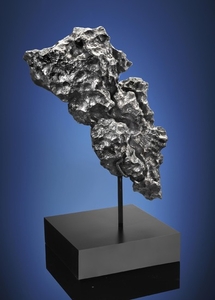CAMPO DEL CIELO — AN AESTHETIC TABLE-TOP IRON METEORITE, Iron, coarse octahedrite – IAB-MG Gran Chaco, Argentina (27°28' S, 60°35' W)
The smooth, highly textured surface is blanketed in a bright metallic patina with chrome accents. The meteorite’s surface is covered with sought-after regmaglypts ,that occurred as this mass entered Earth’s atmosphere and melting caused scalloping to the surface. A neck in the mass separates the orbicular and trigonal ends of this curiously shaped meteorite. Accompanied by a custom armature.
288 x 203 x 189 mm. (11⅓ x 8 x 7½ in.) and 12.49 kg. (27½ lbs)
A compelling meteorite when viewed from any angle and any orientation. An unusually engaging meteorite, Campo del Cielo (“Valley of the Sky”) meteorites were first written about by Spanish explorers in 1576, about 4,000 years after their collision with Earth — which was long before their unearthly origins were understood. It was a large Campo del Cielo meteorite that was the first large meteorite ever displayed in a major museum — specifically the British Museum of Natural History, and Campo del Cielo masses are today found in the finest museums throughout the world. Few have as much character as this superior specimen. A previously unknown portion of the Campo strewn field (the area in which a meteorite shower is "strewn" across the Earth's surface) was recently discovered. Located at a higher elevation than the valley where the majority of the meteorites fell, the meteorites recovered from this region were less susceptible to incursions of ground water and, as a result, exhibit far better preservation — which is evidenced in this unusually shaped example. This meteorite was blasted off its asteroid during an enormous collision with another asteroid; the liberated Campo mass was deflected into an Earth-crossing orbit and eventually slammed into our planet. Depending upon its orientation, this decorative example intrigues or enthralls.
Christie's would like to thank Dr. Alan E. Rubin at the Institute of Geophysics and Planetary Physics, University of California, Los Angeles for his assistance in preparing this catalog note.
View it on
Sale price
Estimate
Time, Location
Auction House
The smooth, highly textured surface is blanketed in a bright metallic patina with chrome accents. The meteorite’s surface is covered with sought-after regmaglypts ,that occurred as this mass entered Earth’s atmosphere and melting caused scalloping to the surface. A neck in the mass separates the orbicular and trigonal ends of this curiously shaped meteorite. Accompanied by a custom armature.
288 x 203 x 189 mm. (11⅓ x 8 x 7½ in.) and 12.49 kg. (27½ lbs)
A compelling meteorite when viewed from any angle and any orientation. An unusually engaging meteorite, Campo del Cielo (“Valley of the Sky”) meteorites were first written about by Spanish explorers in 1576, about 4,000 years after their collision with Earth — which was long before their unearthly origins were understood. It was a large Campo del Cielo meteorite that was the first large meteorite ever displayed in a major museum — specifically the British Museum of Natural History, and Campo del Cielo masses are today found in the finest museums throughout the world. Few have as much character as this superior specimen. A previously unknown portion of the Campo strewn field (the area in which a meteorite shower is "strewn" across the Earth's surface) was recently discovered. Located at a higher elevation than the valley where the majority of the meteorites fell, the meteorites recovered from this region were less susceptible to incursions of ground water and, as a result, exhibit far better preservation — which is evidenced in this unusually shaped example. This meteorite was blasted off its asteroid during an enormous collision with another asteroid; the liberated Campo mass was deflected into an Earth-crossing orbit and eventually slammed into our planet. Depending upon its orientation, this decorative example intrigues or enthralls.
Christie's would like to thank Dr. Alan E. Rubin at the Institute of Geophysics and Planetary Physics, University of California, Los Angeles for his assistance in preparing this catalog note.



